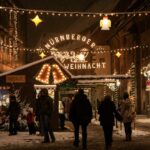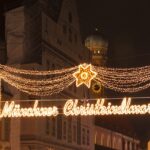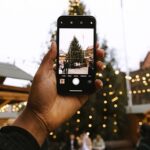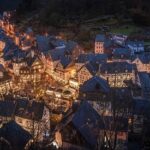
Germany is home to hundreds of Christmas markets, but none carries the prestige, charm, and history quite like the Nuremberg Christkindlesmarkt. Held each Advent in the heart of Nuremberg’s old town, this iconic market draws over two million visitors each year and is considered the gold standard of German holiday traditions.
From its red-and-white striped stalls and the ceremonial arrival of the Christkind to the scent of spicy gingerbread and the glow of handmade decorations, Nuremberg’s market is as much a cultural pilgrimage as it is a festive destination. Whether you’re a first-time visitor or a seasoned Weihnachtsmarkt fan, this guide will help you navigate, appreciate, and fully enjoy Germany’s most famous Christmas market.
Related: German Christmas Markets: A Magical Winter Tradition
A Tradition Since the 1500s
The Christkindlesmarkt’s roots date back to at least 1628, though many historians believe earlier versions may have existed as far back as the mid-1500s. Unlike modern commercial markets, it began as a place where Nuremberg citizens could purchase handcrafted goods and Christmas essentials – decorations, gifts, and seasonal treats.
Today, this history is carefully preserved. Many stalls still sell only handmade or regionally produced items, and the architecture of the old town enhances the feeling that you’re stepping into a living museum of Christmas past.
The Opening Ceremony: The Christkind Arrives
The market officially begins with the appearance of the Christkind, a traditional figure played by a local teenage girl dressed in a golden robe and crown. Standing on the balcony of the Frauenkirche (Church of Our Lady), she recites a poetic prologue that signals the start of the season.
The Christkind isn’t Santa Claus – she’s a symbol of peace, light, and childhood wonder. Her appearance is central to the magic of Nuremberg’s Advent.
Tip: Arrive early for the opening ceremony – the square fills up fast.
Where and When
- Location: Hauptmarkt (Main Market Square), Nuremberg Old Town
- Dates: Late November through Christmas Eve
- Hours: Typically 10am to 9pm (closing earlier on Christmas Eve)
Key Attractions at the Market
With over 180 stalls, Nuremberg’s market is large but thoughtfully arranged. Here are the can’t-miss highlights:
- Lebkuchen Stalls: Nuremberg’s famous gingerbread is sold in dozens of varieties – from traditional Elisenlebkuchen to chocolate-covered or nut-topped forms.
- Zwetschgenmännla: These quirky “plum people” figurines are made from dried prunes and walnuts – a unique Nuremberg tradition.
- Wooden Toys and Crafts: Hand-carved ornaments, nutcrackers, incense smokers, and Schwibbogen are all on offer.
- Traditional Food Stalls: Bratwurst, potato pancakes, roasted almonds, and mulled wine (Glühwein) abound.
Related: German Christmas Market Food: What to Eat and Drink
The Sister Cities Market
Adjacent to the main Christkindlesmarkt is the “Market of Nuremberg’s Sister Cities”, where 20+ international stalls represent global holiday traditions. Here, you can find:
- Scottish shortbread and kilts
- Ukrainian pysanky eggs
- Italian Panettone
- American crafts and treats
This addition brings a multicultural flair to the otherwise traditional atmosphere and highlights Nuremberg’s global connections.
For Children: The Kinderweihnacht
The Nuremberg Kinderweihnacht, just a short walk from the main square, is a specially designed market for families and children. Highlights include:
- A vintage carousel and a Ferris wheel
- Craft tents where kids can make candles, cookies, and decorations
- Santa’s post office, where children can write letters to the Christkind
It’s a safe, magical space that turns market-going into a full family adventure.
What to Eat and Drink
While many German Christmas markets offer regional specialties, Nuremberg has its own distinct culinary traditions:
- Nürnberger Rostbratwurst: Small, spiced sausages grilled over open flames and served three to a bun (Drei im Weckla)
- Elisenlebkuchen: The highest quality Lebkuchen, with high nut content and often gluten-free
- Fränkischer Glühwein: Franconian mulled wine, sometimes made with local blueberries
Also try:
- Hot apple cider (Heißer Apfelsaft)
- Sugar-roasted almonds (Gebrannte Mandeln)
- Mulled beer or Feuerzangenbowle for a stronger kick
Souvenirs to Bring Home
Beyond ornaments and cookies, Nuremberg’s market offers unique gifts:
- Plum people figurines
- Local ceramics and pewterware
- Traditional Advent calendars
- Hand-stitched linens from Franconian villages
Related: Hidden Gems: Small German Christmas Markets Worth Visiting
Market Etiquette and Tips
- Cash is king: While more vendors accept cards now, many still don’t.
- Deposit for mugs: Glühwein is served in collectible mugs – pay a deposit (Pfand) and either return it or keep it.
- Don’t haggle: Prices are fixed and reflect artisan labor.
- Respect traditions: Wait for the host’s “Guten Appetit” before eating at communal tables.
Getting There
- By Train: Nuremberg is well-connected by ICE and regional trains.
- By Plane: Nuremberg Airport is just 20 minutes by subway from the city center.
- By Car: Park-and-ride options are available to avoid congestion.
Accommodations Nearby
Book early – hotels fill up months in advance.
Recommended areas:
- Altstadt (Old Town): Walkable, atmospheric, and closest to the action
- Gostenhof: Trendy, slightly removed, with boutique hotels
- St. Lorenz or St. Sebald districts: Centrally located with historic charm
What Makes Nuremberg Special?
While many German cities host enchanting markets, Nuremberg’s stands apart for its:
- Historic continuity: The market has evolved but not strayed far from its 17th-century roots
- Architectural backdrop: The medieval square, Gothic church, and winding lanes set the stage
- Christkind tradition: It’s not just a market – it’s a cultural performance
- Curation: Strict rules on what can be sold maintain the market’s artisanal integrity
A Timeless Holiday Destination
Visiting the Nuremberg Christkindlesmarkt is like stepping into a snow globe of German tradition. It combines history, food, crafts, music, and warmth into an experience that resonates far beyond the holidays. Whether you go for the sausage or the stars, the Christkind or the crafts, you’ll leave with a deeper appreciation for how Germans celebrate the season.
Continue exploring the series:







